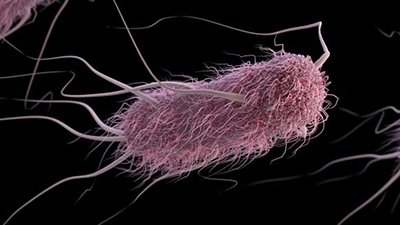
Microscopic Clutch Aids In Flagellum Mobility
ScienceDaily: “Microscopic ‘Clutch’ Puts Flagellum in Neutral” Tiny bacteria-bound flagella have a clutch-controlled microscopic motor much like that of ordinary automobiles, according to research conducted at Indiana University–Bloomington and Harvard University.
The research, which appeared in a recent issue of the journal Science, focused on the flagellum-bearing bacterium Bacillus subtilis. The scientists discovered that the bacteria use a protein clutch to disengage their “tiny but powerful” engines from their flagella.
The discovery of the protein clutch was a complete accident.
Although scientists have long known how the motor moves the flagella, what was unknown was what keeps the flagella from spinning. The protein clutch is, in fact, very similar to a car’s clutch. As it interacts with a rotor protein, the rotor itself changes shape and, as a result, disengages from the flagellum’s proton-powered engine.
Interestingly, the discovery of the protein clutch was a complete accident—the scientists were actually hoping to learn more about what causes communal behavior (biofilm formation) in B. subtilis, but ended up learning about the flagella because biofilms may be disrupted by “hyperactive bacterial cells whose flagella continue to spin.”
Also exciting is that the find may help nanotechnology experts figure out ways to regulate the tiny engines they design. The news release points out that the B. subtilis flagella can rotate at more than 200 times a second and is driven by a significant horsepower considering its tiny size.
Surely this incredible discovery—one of the important details of the even-more-incredible microscopic motor—couldn’t have evolved by chance, right? Apparently that’s not the view of project leader Daniel Kearns, an Indiana University biologist. “We think it’s pretty cool that evolving bacteria and human engineers arrived at a similar solution to the same problem.”
The real credit, of course, goes to the awesome Creator, who—with neither microscopes nor millions of years—engineered this bacterium to function in its environment via the almost-unfathomable, microscopic complexity of the flagellum motor.
For more information:
Remember, if you see a news story that might merit some attention, let us know about it! (Note: if the story originates from the Associated Press, Fox News, MSNBC, the New York Times, or another major national media outlet, we will most likely have already heard about it.) And thanks to all of our readers who have submitted great news tips to us.
(Please note that links will take you directly to the source. Answers in Genesis is not responsible for content on the websites to which we refer. For more information, please see our Privacy Policy.)
Recommended Resources

Answers in Genesis is an apologetics ministry, dedicated to helping Christians defend their faith and proclaim the good news of Jesus Christ.
- Customer Service 800.778.3390
- © 2024 Answers in Genesis






